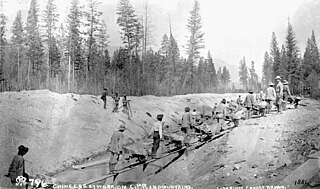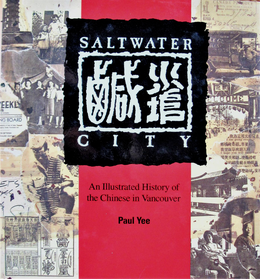
There has been a significant history of Chinese immigration to Canada, with the first settlement of Chinese people in Canada being in the 1780s. The major periods of Chinese immigration would take place from 1858 to 1923 and 1947 to the present day, reflecting changes in the Canadian government's immigration policy.

Chinese Canadians are Canadians of full or partial Chinese ancestry, which includes both naturalized Chinese immigrants and Canadian-born Chinese. They comprise a subgroup of East Asian Canadians which is a further subgroup of Asian Canadians. Demographic research tends to include immigrants from Mainland China, Hong Kong, and Macau, as well as overseas Chinese who have immigrated from Southeast Asia and South America into the broadly defined Chinese Canadian category.

Toronto Chinatowns are ethnic enclaves in Toronto, Ontario, Canada, with a high concentration of ethnic Chinese residents and businesses. These neighbourhoods are major cultural, social and economic hubs for the Chinese-Canadian communities of the region. In addition to Toronto, several areas in the Greater Toronto Area also hold a high concentration of Chinese residents and businesses.

Chinatown is a neighbourhood in Vancouver, British Columbia, and is Canada's largest Chinatown. Centered around Pender Street, it is surrounded by Gastown to the north, the Downtown financial and central business districts to the west, the Georgia Viaduct and the False Creek inlet to the south, the Downtown Eastside and the remnant of old Japantown to the northeast, and the residential neighbourhood of Strathcona to the southeast.
This article discusses Chinatowns in the Americas, urban areas with a large population of people of Chinese descent. The regions include: Canada, the United States, and Latin America.
Like many other communities, the older Chinatowns face certain social problems. Although Chinatowns are now generally viewed and valued as tourist attractions, their earlier reputation was that of dangerous or dilapidated ghettos and slums, sites of brothels, opium dens, and gambling halls.

Stadium–Chinatown is an elevated station on the Expo Line of Metro Vancouver's SkyTrain rapid transit system. The station is located in Vancouver, British Columbia, Canada, at the eastern entrance of the Dunsmuir Tunnel. It is one of four stations on the Expo Line that serve Downtown Vancouver.

Calgary's Chinatown is a district of Calgary located along Centre Street in the northeast area of Downtown Calgary immediately west of the Downtown East Village. Calgary's Chinese Cultural Centre with its traditional architecture and decor is the largest facility of its kind in North America. The Dragon City Mall is also located in this district.

Chinatown in Montreal is located in the area of De la Gauchetière Street in Montreal. The neighbourhood contains many Asian restaurants, food markets, and convenience stores as well being home to many of Montreal's East Asian community centres, such as the Montreal Chinese Hospital and the Montreal Chinese Community and Cultural Center.

George Chow is a Canadian politician. He was elected as a New Democratic Party Member of the Legislative Assembly of British Columbia in the 2017 provincial election, representing the riding of Vancouver-Fraserview. He is currently the Minister of State for Trade. He was previously a two-term Vancouver City Councillor who was elected as a member of the Vision Vancouver party in 2005 and 2008. Prior to being elected Chow worked at BC Hydro for over 30 years, where he worked part-time when he was a councillor.

East Vancouver is a region within the city of Vancouver, British Columbia, Canada. Geographically, East Vancouver is bordered to the north by Burrard Inlet, to the south by the Fraser River, and to the east by the city of Burnaby. East Vancouver is divided from Vancouver's "West Side" by Ontario Street.

The Chinatown in Victoria, British Columbia is the oldest Chinatown in Canada and the second oldest in North America after San Francisco's. Victoria's Chinatown had its beginnings in the mid-nineteenth century in the mass influx of miners from California to what is now British Columbia in 1858. It remains an actively inhabited place and continues to be popular with residents and visitors, many of whom are Chinese-Canadians. Victoria's Chinatown is now surrounded by cultural, entertainment venues as well as being a venue itself. Chinatown is now conveniently just minutes away from other sites of interests such as the Save-On-Foods Memorial Centre, Bay Centre, Empress Hotel, Market Square, and others.

Miss Chinese Vancouver Pageant, also known as MCV and formerly branded as Miss Chinese (Vancouver) Pageant, is an annual beauty pageant organized by Fairchild TV that selects Vancouver's representative for the annual Miss Chinese International Pageant that is held in Hong Kong, organized by TVB. The current Miss Chinese Vancouver is Cindy Wu (吳昕宸) winner of the 2021 pageant.
An ethnoburb is a suburban residential and business area with a notable cluster of a particular ethnic minority population. Although the group may not constitute the majority within the region, it is a significant amount of the population. That can greatly influence the social geography within the area because of cultural and religious traditional values exhibited. Ethnoburbs allow for ethnic minority groups to maintain their individual identity, but that may also restrict their ability to fully assimilate into mainstream culture and society.
Jean Bessie Lumb,, née Wong (1919–2002) was the first Chinese Canadian woman and the first restaurateur to receive the Order of Canada for her community work. Most notably, she was recognized for her pivotal role in changing Canada’s immigration laws that separated Chinese families and for her contribution in saving Toronto's First Chinatown and Chinatowns in other cities.

The Chinese Cultural Centre is a building in Calgary, Alberta, Canada. It is located on the north-eastern side of downtown and was completed in September 1992.
Chinatowns in Canada generally exist in the large cities of Vancouver, Ottawa, Calgary, Edmonton, Toronto, and Montreal, and existed in some smaller towns throughout the history of Canada. Prior to 1900, almost all Chinese were located in British Columbia, but have spread throughout Canada thereafter. From 1923 to 1967, immigration from China was suspended due to exclusion laws. In 1997, the handover of Hong Kong to China caused many from there to flee to Canada due to uncertainties. Canada had about 25 Chinatowns across the country between the 1930s to 1940s, some of which have ceased to exist.
The history of Chinese Canadians in British Columbia began with the first recorded visit by Chinese people to North America in 1788. Some 30–40 men were employed as shipwrights at Nootka Sound in what is now British Columbia, to build the first European-type vessel in the Pacific Northwest, named the North West America. Large-scale immigration of Chinese began seventy years later with the advent of the Fraser Canyon Gold Rush of 1858. During the gold rush, settlements of Chinese grew in Victoria and New Westminster and the "capital of the Cariboo" Barkerville and numerous other towns, as well as throughout the colony's interior, where many communities were dominantly Chinese. In the 1880s, Chinese labour was contracted to build the Canadian Pacific Railway. Following this, many Chinese began to move eastward, establishing Chinatowns in several of the larger Canadian cities.

Saltwater City: An Illustrated History of the Chinese in Vancouver is a 1988 book by Paul Yee, published by Douglas & McIntyre. It discusses the development of the Chinese Canadian community in Vancouver, British Columbia.
Chinese Canadians are a sizable part of the population in Greater Vancouver, especially in the Chinese communities in the city of Vancouver and the adjoining suburban city of Richmond. The legacy of Chinese immigration is prevalent throughout the Vancouver area.













